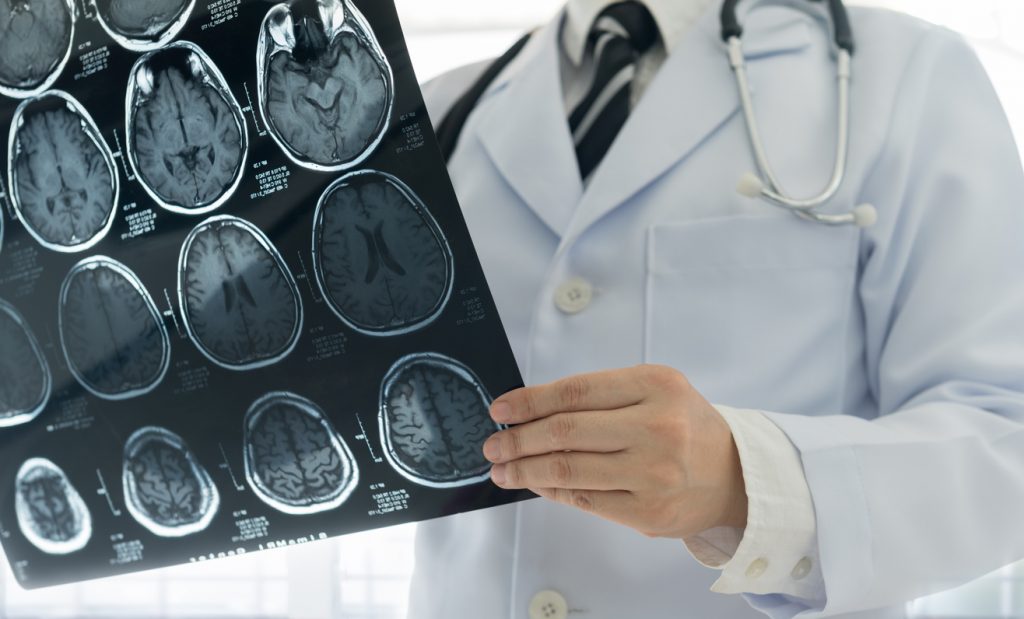Video transcript
Hello, I am Julian Rodrigues, a Perth-based neurologist. I have a sub-speciality in the field of movement disorders, which includes Parkinson’s disease, tremors and various other disorders of movement. Today I’m talking about Parkinson’s disease and treatments both for the early stages and for the more advances stages of the disease.
What causes Parkinson’s disease?
Parkinson’s disease was first recognised in the 1800s by the man who the disease is named after, and he actually made the diagnosis by simply observing people in the street. Subsequently we’ve been able to determine that it is due to a loss of brain cells, in a specific area of the brain called the substantia nigra. Where is that? It’s in the base of the brain, in the brainstem. It contains cells that produce dopamine. They’re part of a network called the basal ganglia, which is involved in spontaneous and voluntary movement.
So this tiny little area, the size of two thumbnails, is heavily connected with areas higher up in the brain and also areas lower down in the brainstem. We start to see Parkinson’s symptoms when you’ve lost 60 to 70 per cent of cells in this area. We do not know why people are losing cells in that region. It’s still an area of research.
Find and instantly book your next health appointment with HealthengineBook your health appointments online
What are the symptoms of Parkinson’s disease?
Once you’ve developed the symptoms, it continues to progress gradually.
The first symptoms can be something obvious like a tremor. A tremor is a shaking of the part of the body that’s first affected. It’s typically on one side, it’s typically in the hand, or there can be different presentations. If tremor is the first symptom, it’s often diagnosed early.
The other main symptoms are slowness of movement or bradykinesia, and rigidity which is something we feel – patients don’t necessarily notice it, but it can look like or feel like stiffness, usually in the limb or the back.
So those three main symptoms of tremor, slowness and stiffness can sneak up on people. So slowing down in walking before you get the typical shuffling walking pattern of Parkinson’s. So there is a gradual onset of symptoms.
Patients may be diagnosed early and get appropriate management, which is good. Or be delayed several years, be misdiagnosed with musculoskeletal problems, shoulder problems, have surgeries et cetera, before coming to diagnosis.
Who gets Parkinson’s disease?
As with all brain degeneration conditions, the number of patients with Parkinson’s increases with age. So we could say it is a disease of ageing. Having said that, there is a large number of patients where it will come on in their 50s and 60s, and in about 10% of patients the disease comes on under the age of 40. It’s very rare for it to come on under the age of 20 but say that 10% is 20-40 year olds. So we call it young onset PD versus older onset PD.
There are genetic risk factors but at this point in time we do not use genetic testing in the clinic. All we can say to people is that yes, there are genetic associations with Parkinson’s disease. We can say there are environmental associations, for example being a farmer or drinking well water. But we can’t put it all together. I mean, one of the associations is smoking, which actually reduces the risk of Parkinson’s disease. So while we can point at these associations, patients often want us to say, “Why have I got it?” And we generally can’t tell them that.
Parkinson’s disease and quality of life
How do the symptoms of Parkinson’s affect people and their quality of life? If we just take tremor for example. It’s a constant rhythmic movement of a part of your body. It can be distressing, it can be annoying. If it’s purely rest tremor, which is often the case – that’s the tremor that occurs when you’re relaxing and goes away when you go to move – then that’s less of a disability, it can just be distressing.
Some patients will also have the tremor return when they go to hold their hand up. It will start shaking again, which impairs your ability to function. So that’s the tremor I would say if you mix in the slowness of movement, again in the upper body, you’re losing hand dexterity, losing fine motor skills, handwriting becomes small and messy. And if Parkinson’s affects your dominant side first, then people will draw that to your attention: “There’s something wrong with my handwriting.”
In the lower body there’s difficulty with walking. You can’t just get up and walk. There’s a phenomenon called freezing, where the normal motor pattern for walking is blocked. You’ll go to get up and walk and your feet simply won’t move, you’ll have to wait, or you’ll have to try to side step or other strategies and eventually you’ll get walking. When you do get walking, your walking speed is not as quick as it was. And then if you’re distracted you can get another freezing episode, which is you suddenly stop walking, which can cause falls.
There’s difficulty with simple bodily movements: getting in and out of chairs, getting in and out of the car, turning over in bed at night. The stiffness in the muscles can be experienced as pain.
So they’re the main symptoms that we tell people about.
The other important group of symptoms that is being increasingly recognised are called non-motor symptoms. So everyone knows that Parkinson’s causes shuffling, shaking et cetera, but there’s a number of body systems that are affected, unrelated to movement.
There’s a high incidence of mood disorders. People can simply be unmotivated or apathetic. Pain can occur, there can be behavioural disorders, usually with the condition or medications used to treat it. There can be sexual dysfunction, constipation and all these other things.
So not to be pessimistic, but I’m just mentioning these things because there may be a symptom that’s not recognised as part of Parkinson’s disease by the patient or their treating doctor that can be effectively managed.
Video kindly featuring:
Dr Julian Rodrigues MBBS FRACP; Consultant Neurologist at Hollywood Medical Centre, and Editorial Advisory Board Member of the Virtual Neuro Centre.
All content and media on the HealthEngine Blog is created and published online for informational purposes only. It is not intended to be a substitute for professional medical advice and should not be relied on as health or personal advice. Always seek the guidance of your doctor or other qualified health professional with any questions you may have regarding your health or a medical condition. Never disregard the advice of a medical professional, or delay in seeking it because of something you have read on this Website. If you think you may have a medical emergency, call your doctor, go to the nearest hospital emergency department, or call the emergency services immediately.







